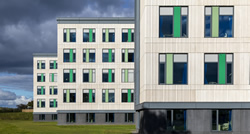| The Grange University Hospital features modular windows by Kawneer. |
 |
| Architectural glazing systems by leading UK manufacturer Kawneer that were installed off-site helped elements of a £350 million new hospital to finish almost a year ahead of schedule and help with the Covid crisis. |
| Kawneer’s AA®720 HI Reflex Plus windows were fabricated into precast sandwich panels at the main contractor’s off-site factory for installation at The Grange University Hospital at Llanfrechfa Grange in Gwent, South Wales. |
| The Kawneer windows were complemented by the manufacturer’s AA®100 zone-drained curtain walling with 50mm sightlines, and three types of entrance doors – AA®720s, AA®190 TBs and folding/sliding AA®3720s. |
| The windows featured both glazed and spandrel panels which were thermally enhanced to comply with the thermal model, using a mineral wool core to comply with Building Regulations as well as providing bright colours for the façade in the form of orange face caps. |
| They also included feature pods designed by specialist sub-contractor and approved Kawneer installer/dealer Bennett Architectural Aluminium Solutions which were extruded by Kawneer at its factory in Runcorn, Cheshire. |
| Designed by architects BDP to BIM Level 4, the 560-bed Grange has already won two awards – Constructing Excellence Wales for Digital Construction and an Off-site Award. It comprises 11 operating theatres, one Cat 3 Laboratory, two MRI suites, two CT suites and an education block. |
| Previously known as the Specialist and Critical Care Centre, it is the centre piece of a new model of healthcare delivery, serving more than 600,000 people, and will deal with all major emergencies, including the Covid pandemic, as well as 40 specialist services, with a helicopter pad for patients who need to arrive by air ambulance. |
| Careful modelling of staff and patient flows in the design phase allows early streaming to a point of care and access to timely and expert care. This is supported by dedicated circulation systems for front-of-house and back-of-house services, enhancing patient privacy. |
| Designed to be flexible, adaptable and expendable, the 55,000m2 hospital’s universal rooms allow operational flexibility and blurring of departmental boundaries to deal with changing demand. |
| Beds were released 30% earlier than the original programme through productivity efficiencies during the Covid crisis while the DfMA (MMC) approach saved 237,000 working hours - equivalent to a 23% overall planned programme saving. |
| In addition, 821 precast columns and 1,200 precast wall modules were installed, representing 85% and 95% working hours savings respectively. |
| Victoria Head, project director of project and cost managers Gleeds, said: “With the best will in the world, fundamentally, had this been a traditional build with the same start date [2017] we would not have been in a position to offer support to this national pandemic and the NHS. |
| “We’ve always been proud of the MMC involved at the Grange and the programme savings which it offered compared to a traditional build, but never have the benefits been more apparent than during this crisis.” |
BDP lead designer Adrian Hitchcock said: “We have used Kawneer systems on multiple projects. Familiarity with their products from previous successful use is a positive. Demonstrating compliance is important and Kawneer do this.” |
| Work on the build involved careful segregation fully endorsed by infection and building control and fire officers. |
| Rob Bennett, pre-construction director for Bennett Architectural Aluminium Solutions, said: “The hospital was a compelling case for the use of DfMA in large-scale healthcare construction projects, even opening far ahead of schedule to treat patients during the pandemic. |
| “Kawneer products were specified due to the company’s experience with Bennett’s in delivering extensive offsite construction projects in the healthcare sector.” |
| Judith Paget, chief executive of the Aneurin Bevan University Health Board, said: “It will help us to create a much improved care environment, timely access to emergency care, and ensure patients get the best outcomes from their care.” |
| |
| |
| |
| |